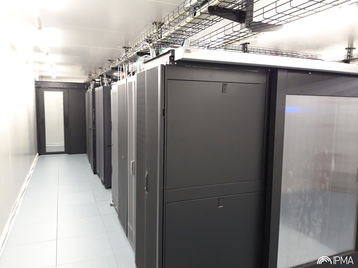Portugal's national weather agency has launched a new supercomputer.
The new system, known as Atlântico, was inaugurated at the Institute of the Sea and Atmosphere’s (IPMA) headquarters in Lisbon, on January 20.
The event was attended by António Costa Silva, minister of economy and sea, and José Maria Costa, secretary of state for the sea.
The HPC is powered by AMD Epyc Milan processors with 3.840 cores giving a performance of 161 Tflops and uses the Infiniband HDR 200 Gbit. The supercomputer is expected to multiply the IPMA’s computational capacity by 20, and to ‘significantly improve the forecast quality of the models used to issue meteorological warnings, in forecasts for maritime meteorology, in supporting aeronautical meteorology, in meteorological fire risk indices, as well as in many other sectors,’ according to a press release.
The new Atlântico system involved “an investment of more than one million euros”, which was financed by the Sea component of the Recovery and Resilience Plan (PRR), and the supercomputer will primarily focus on the Ocean-Atmosphere Modeling System, with high spatial and temporal resolution.
IPMA has not released the details surrounding the hardware used in the supercomputer, merely saying that it has been ‘designed with the latest technologies’ and will be able to increase the resolution of numerical forecast models, their execution speed, and the geographical area covered.
The press release says: “It will allow better integration with global models, both with regard to the sea and with regard to the atmosphere, and will benefit from the increased coverage allowed by the new sensors and systems, enabling the expansion of the operational geographical domain that will now encompass mainland Portugal, adjacent Atlantic area and Madeira Archipelago, which represents the Atlantic area of national responsibility.”
Up till now, IPMA ran its weather models twice a day and some parts four times a day. With Atlântico, the institute will be able to run all meteorological models four times a day, increasing to eight times in the future.
At the inauguration, minister of the sea António Costa Silva said: “[The supercomputer is] the first action to be carried out and is part of a larger plan to reinforce the collaborative network of ocean technologies, whose other components are in progress respecting the rules of public procurement. 243 million euros are available for the economy of the sea, 87 million of which for blue hubs, i.e. the creation of infrastructure for the sustainable development of the sea. One of them is the great pole of the IPMA.”
The IPMA is also developing new radars for data points to feed Atlântico in the center and the south of Portugal by the end of the year. The radars, which measure wind speed in two directions, as well as the presence of water droplets and ice crystals, will provide data to the supercomputer alongside existing radars and satellites, enabling IPMA to produce forecasts at a precision level of 1-2 kilometers.
IPMA acquired an IBM P2 system in the year 2000, which was later replaced with a P7 and then P8.
DCD has reached out to the IPMA for more information on the supercomputer’s capacity and hardware.

